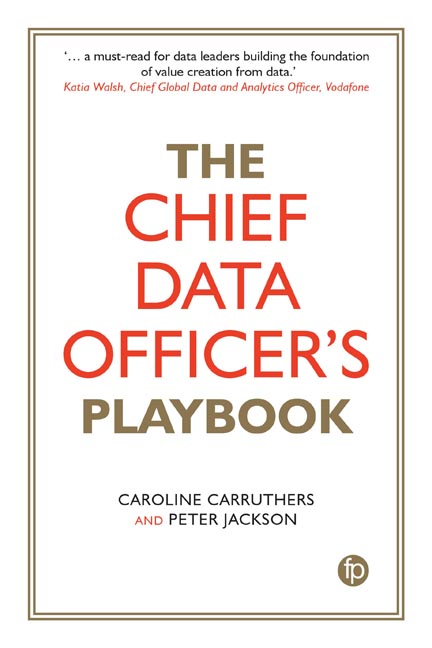Book contents
- Frontmatter
- Contents
- List of figures
- Preface
- Acknowledgements
- About the authors
- Glossary of technical terms
- 1 Why does any organisation need a Chief Data Officer?
- 2 Secret ingredients of a Chief Data Officer
- 3 The first 100 days
- 4 Delivering a data strategy in the cauldron of BAU
- 5 Avoiding the hype cycle
- 6 Relating to the rest of the business, especially the C-Suite
- 7 The Chief Data Officer as a disruptor
- 8 Building the Chief Data Officer team
- 9 The next 300 days
- 10 The different generations of Chief Data Officers
- 11 What type of Chief Data Officer are you?
- 12 How to present yourself as a Chief Data Officer
- 13 Tinker, tailor, soldier, data …
- 14 The Chief Data Officer and the technology
- 15 The hoarding mentality and how to break it
- 16 Data and information ethics
- 17 The Chief Data Officer and data governance
- 18 The data revolution
- 19 Advice to business owners, CEOs and the board
- 20 Conclusion
- Index
Preface
Published online by Cambridge University Press: 08 June 2018
- Frontmatter
- Contents
- List of figures
- Preface
- Acknowledgements
- About the authors
- Glossary of technical terms
- 1 Why does any organisation need a Chief Data Officer?
- 2 Secret ingredients of a Chief Data Officer
- 3 The first 100 days
- 4 Delivering a data strategy in the cauldron of BAU
- 5 Avoiding the hype cycle
- 6 Relating to the rest of the business, especially the C-Suite
- 7 The Chief Data Officer as a disruptor
- 8 Building the Chief Data Officer team
- 9 The next 300 days
- 10 The different generations of Chief Data Officers
- 11 What type of Chief Data Officer are you?
- 12 How to present yourself as a Chief Data Officer
- 13 Tinker, tailor, soldier, data …
- 14 The Chief Data Officer and the technology
- 15 The hoarding mentality and how to break it
- 16 Data and information ethics
- 17 The Chief Data Officer and data governance
- 18 The data revolution
- 19 Advice to business owners, CEOs and the board
- 20 Conclusion
- Index
Summary
We were recently on a panel at a conference discussing how to harness value from data – we've changed the discussion topic slightly so as to not identify the conference, event or other participants; to protect the ‘not-so-innocent’. This topic, or a closely related one, has been a regular feature of the panels and discussions we've been involved with over the past two years. It seems everyone is trying to get to the heart of that question and find the answer. Data has been seen as such an inconsequential thing, that just seemed to be there, in the past; but there is a growing respect for data as a really fundamental asset – which is a great thing.
Everyone knows, because we've all been told many times recently, that data is the new oil. The question that then leads out of this is the one we have been facing: if data is the new oil, how does an organisation get value out of it? It is all very well having struck oil, but if you don't know how to get it out of the ground, or how to refine it into useful products, or that it can be transformed and manufactured into valuable products or consumed to create energy – what use is the oil in the ground?
On that recent panel we began by responding to some prepared questions. There were some great and experienced minds on the panel: leaders in their respective fields and all practitioners from the hard edge of industry, business and commerce. We each took turns to discuss the great value that could be derived from data. We each provided stunning examples of what could be done with data to transform, disrupt and innovate organisations and industries. It is interesting to note that the topic was definitely worded as ‘digital assets’ but we all spoke about ‘data’, and used the term data and not digital asset.
- Type
- Chapter
- Information
- The Chief Data Officer's Playbook , pp. xi - xviPublisher: FacetPrint publication year: 2017



